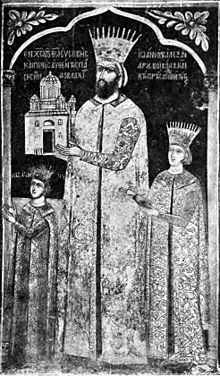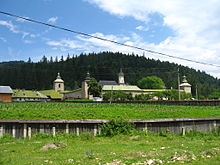Alexandru Lăpuşneanu
Alexandru Lăpuşneanu (l) , actually Petru Alexandru , (* after 1500 in Lăpuşna (Hînceşti) ; † March 11, 1568 in Slatina Monastery ) was a prince of Moldova who ruled between 1552 and 1561 and between 1564 and 1568. He later called himself Lăpuşneanu (l) based on his place of birth .
history
After the assassination of the voivode Ștefan Rareş on September 8, 1552, some boyars Ioan Joldea transferred power under the leadership of Sturdza and Movilă . This led to tensions with the court in Krakow , because King Sigismund II August had intended to enthrone Alexandru Lăpuşneanu, illegitimate son of Bogdan III, the blind man and an Anastasia from Lăpuşna and grandson of Stefan the Great . With the help of the Polish cavalry officer Seniawiski and 3,000 horsemen, however, it was possible to lure Joldea into an ambush at Șipote on the way to his anointing in Suceava and to take him prisoner.
First rule
Alexandru deposed Prince Ioan Joldea with Polish help, who then had to spend the rest of his life in a monastery. He ascended the throne on September 12, 1552. Sultan Suleyman I also sanctioned this act on October 24, 1552. The boyars soon sought to consolidate their power, which caused a conflict with Lăpuşneanu. So the nobles tried to replace him with the younger son of Petru Rareș. Their plot has been exposed. As a result, many landowners lost their property, the confiscated goods increased, among other things, the princely property. As a result, Lăpuşneanu put the country under Polish sovereignty by means of an oath of loyalty, and he also undertook to help Poland with 700 riders in the event of war (June 22, 1553). This act displeased Emperor Ferdinand I , because King Sigismund was the brother of Queen Isabella of Hungary and her husband King Johann Zápolya was his enemy and competitor for the Hungarian crown . But the Dīwān also rejected this connection, which is why Alexandru was cited to Constantinople in early 1555 . Instead of going there in person, however, he sent a considerable sum of money, which the Turks took benevolent of note. After he also helped them in 1556 to bring Isabella, who had fled to Poland, back to the throne in Cluj , he was sure of both Polish and Turkish protection. In 1553 (completed in 1564) he had a monastery of the same name built in the village of Slatina near Suceava , which was dedicated to the Transfiguration of the Lord . He also had a church built in Lviv for the local Orthodox Christians.
Nevertheless, a certain Ioan Jacob Heraclides (Ion Nistor called him Vasilic), son of the despot of Samos , managed to overthrow him. First he had hired himself in the Moldovan army and claimed that he was a relative of Lăpuşneanu's wife Ruxandra, a daughter of Petru Rareş. Together with the boyar Moarenoc and others, however, he forged plans for a coup. The two then had to flee to Transylvania. Persecuted here too, they moved on to what is now Slovakia, where Heraclides found in the person of the Pole Albert Laski a financier to raise an army against Alexandru. Laski lent him 10,000 gold coins. The first attempt to seize power failed, but in the end Jacob defeated the Moldavians, this time also with the support of Emperor Ferdinand, on November 10, 1561 at Verbia near Dorohoi . Eight days later he ascended the princely throne and was financially supported by the Jewish diplomat and banker in Ottoman service, Joseph Nasi . He went down in Romanian history as Despot Vodă during his brief reign .
Interim period
After Despot Vodă made Lutheranism the state church and banned the worship of icons, the deeply religious Orthodox population was deeply upset. He also raised extremely high taxes in the country and wanted to marry a foreigner, a Polish woman. This led to a boyar conspiracy led by Hatman Ștefan Tomşa . He could no longer expect any support from Albert Laski because he had not yet started to repay his debts. Faced with a major uprising, he retired to the Suceava fortress and withstood a three-month siege. Finally Jacob was captured in October 1563 and personally slain by Tomșa with a mace.
The latter was chosen as the new prince of Moldova and immediately had to repel an invasion of his country by the neighboring Wallachian prince Petru cel Tânăr , but was unable to obtain recognition as the rightful ruler of Moldova by the Ottoman Empire.
Second rule
After Tomşa, with Ottoman, and above all financial, help in the person of the above-mentioned Joseph Nasi and military help from the Transylvanian Prince Johann Sigismund Zápolya, and fled to Poland, where King Sigmund II had him executed on a flimsy pretext, Alexandru Lăpuşneanu returned returned to power in March 1564. That had cost him more than 200,000 gold pieces, and the Turkish and Tatar troops had plundered and robbed the country during the expulsion of Tomşa. The prince became increasingly suspicious and vengeful. So he invited the numerous boyars who had supported his predecessors, especially Jacob, to a general boyar meeting as a token of goodwill. According to a Polish document dated November 1564, during the discussions he had twelve of them killed by foreign mercenaries, according to the report of the Moldovan chronicler Grigore Ureche even 47. He kept the confiscated property for himself, but also gave away parts of it, he confirmed in A document dated May 7, 1565 from the Wassilko family not only confirms the legality of Prince Alexander's document from 1428, but also gave her joint ownership of a large number of villages in northern Moldova. He also gifted the Chipriana monastery with a variety of goods: Lozeni, Preajolteni, Onesti, Sadova, Baliceni, Vorniceni, Dumeni and others.
Soon afterwards, in order to weaken the country's defensive strength, the Turks asked him to demolish all of the stone fortresses of the Moldova except for Hotin , which they wanted to keep as a base of operations. The prince reacted with cunning. He had some fortresses of a lower ranking such as Roman and Crăciun set on fire, which even damaged them, but not destroyed them. Through a clever foreign policy, he managed to get the fortresses of Ciceu and Cetatea de Baltă back into his possession. At that time the princely residence of Suceava also moved to Iași , which thus became the capital of the Vltava . In order to have closer proximity to the court, Iasi also became the seat of the Orthodox Metropolitan .
At the beginning of March 1568 he became seriously ill with a high fever, pain and chills. Thereupon he had his eldest son elected as Bogdan IV. Lăpuşneanu as his successor on March 9th of that year and entered the Slatina monastery founded by him under the name Pahomie , where he died two days later. He, his wife and two of their daughters were buried there. He had a total of 13 children, both legitimate and illegitimate. In addition to his legitimate son Bogdan, two illegitimate sons subsequently ascended the throne of Moldova: Aron Tiranul and Petru Cazacul .
The writer Constantin Negruzzi made the prince popular with his historical novella "Alexandru Lăpuşneanu", but he stylized him extremely negatively, which does not correspond to the facts. Numerous streets and boulevards in Romania are named after the prince .
See also
literature
- Constantin Negruzzi: Alexandru Lăpuşneanu. Editura pentru literatură, Bucharest 1966.
- Gheorghe Punga: Țara Moldovei în vremea lui Alexandru Lăpuşneanu (German: The Principality of Moldau at the time of Alexandru Lăpuşneanu). Publishing house of the University of Alrxandru I. Cuza, Iaşi 1994.
Individual evidence
- ^ Lăpușneanu, Alexandru. In: Andrei Brezianu, Vlad Spânu: The A to Z of Moldova. Scarecrow Press, Lanham 2010, ISBN 978-0-8108-7211-0 , p. 208 ( online ).
- ↑ a b Alexandru Lăpuşneanu on moldovenii.md
- ↑ a b c Ion Nistor: Istoria Basarabiei. Editura Humanitas, Bucureşti 1991, ISBN 973-28-0283-9 , p. 77 ff.
- ↑ Ken Parry: The Blackwell Companion to Eastern Christianity. Wiley-Blackwell, Oxford 2010, p. 195.
- ↑ a b Alexandru Lăpuşneanu na fost deloc tiran aşa cum la prezentat Negruzzi în nuvela sa
- ↑ Lucavăţ (I)
| personal data | |
|---|---|
| SURNAME | Alexandru Lăpuşneanu |
| ALTERNATIVE NAMES | Petru Alexandru (real name) |
| BRIEF DESCRIPTION | Voivode of the Principality of Moldova |
| DATE OF BIRTH | after 1500 |
| PLACE OF BIRTH | Lăpușna (Hîncești) |
| DATE OF DEATH | March 11, 1568 |
| Place of death | Slatina Monastery |


